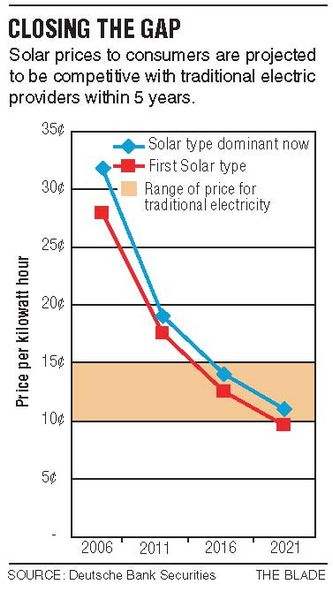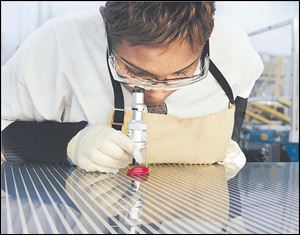
Analysts give First Solar edge in race for cost efficiency
7/15/2007

An employee of First Solar's Perrysburg Township plant uses a magnifier to examine the spacing of laser scribes on a solar panel.
HEIRS OF John Walton, son of the founder of the Wal-Mart retailing chain, have added more than $2 billion to their wealth in recent months. And it had nothing to do with sales of clothes, electronics, and small appliances.
The source of the boost is their 54 percent ownership stake in First Solar Inc., a Phoenix firm that began in metro Toledo, where the company continues to conduct research and produce thousands of solar panels annually.
The firm's lofty market value of $8.4 billion - more than for glass bottle maker Owens-Illinois Inc. or either of the other two area Fortune 500 companies - is a sign that Wall Street is beginning to take seriously the company's claims that it will make solar power competitive with traditional sources of electricity in three years.
Its stock rose from $25 when it was offered to the public last fall to $115.97 in trading on the Nasdaq market Friday.
"It is absolutely achievable," Rhone Resch, president of the 600-member Solar Energy Industries Association, said of the company's goal of making solar commercially viable by 2010.
"They are the first lower-cost manufacturer of solar," he said.
During a recent visit to the First Solar's Perrysburg Township plant, Mr. Resch said he was "blown away" by progress there.
"It's a truly state-of-the-art facility. They are well positioned to scale up manufacturing in a way we have not seen."
The company, which recently opened a plant in the former East Germany and plans two additional plants in Malaysia, is the nation's largest producer of a new style of less costly solar panels known as thin-film.
By 2008, First Solar will be among the top five or 10 worldwide, Mr. Resch said.

Company officials declined to comment for this story.
But in regulatory filings, executives state: "Our objective is to become, by 2010, the first solar module manufacturer to offer a solar electricity solution that competes on a non-subsidized basis with the price of retail electricity in key markets in North America, Europe, and Asia."
The filing continued, "We believe that we will need to reduce our manufacturing costs per watt by an additional 40 to 50 percent, assuming prices for traditional energy sources remain flat on an inflation-adjusted basis."
Most of the growth at First Solar, which produces large panels for solar-energy "farms" and rooftops of large commercial buildings, has resulted from government subsidies in Europe, especially in Germany.
The U.S. government offers a 30 percent tax credit for solar systems, but the program will expire in 2008 unless Congress extends it. First Solar sales are not large in America.
The company hopes to sell panels at prices that will allow users to offer retail energy buyers power prices of 8 to 11 cents a kilowatt hour in three years, Michael Ahearn, chief executive, said in an interview at a recent industry conference. That would make solar competitive with traditional power, he said.
Utilities can buy power now from low-cost coal-fired plants for about 4 cents per kilowatt hour, and sell it to customers for about 12 cents.
But in places with high energy costs, such as Hawaii and California, solar is competitive with traditional electricity, said Mr. Resch, of the Solar Energy Industries Association.
In Hawaii, electricity can cost 30 cents per kilowatt hour. In California during periods of peak use, commercial users pay as much as 42 cents.
When most people think about solar energy, they picture panels on rooftops of homes. First Solar doesn't sell to that market. Rather, it mostly supplies commercial users and people who build solar energy factories by spreading panels over vast areas and then piping power into the electricity grid.
Among those who believe First Solar is within sight of its goal are analysts at Deutsche Bank Securities.
Improvements allowed the firm to cut production costs to $1.29 per watt in the first quarter. That is the lowest cost of any producer.
Yet, to become competitive with traditional electricity, production costs must be reduced to 75 to 90 cents.
However, First Solar's cost advantages over conventional solar panels shrink when installation costs are added in because the firm's panels are more difficult to install.
The company is working on simplifying the process, executives state in regulatory filings.
Second-generation panels like those produced by First Solar account for 8.3 percent of panel sales worldwide, up from 5 percent in 2004, reports indicate.
They are made with a thin-film deposit of semiconductor on a surface such as glass or stainless steel. First Solar uses glass.
They are gaining popularity because they are less costly to manufacture than traditional panels.
Traditional panels, which hold 92 percent of the market now, are made with silicon wafers. In recent years, costs for a key raw material, polysilicon, have shot up because it is in short supply.
Among so-called thin-film producers, several technologies are competing for supremacy.
The key question is which material, or compound, is best to use for creating a semiconductor. Materials include amorphous silicon, copper indium gallium selenium or CIGS, and cadmium telluride. So far, "CdTe," which is used by First Solar, appears to have a slight lead.
But third and-fourth generation technologies are in development. And some analysts believe First Solar is experimenting with different technologies.
Overall, Deutsche Bank analysts see a bright future for solar energy.
"Cost of solar generated electricity will achieve grid-price parity in five to seven years," they wrote in a lengthy report on the subject.
First Solar promises to be ahead of the pack.
It currently operates three production lines with a capacity to produce 90 megawatts of solar panels annually at a factory in Perrysburg Township's Cedar Industrial Park.
In Germany, a recently completed plant will have four lines with a capacity of 120 megawatts. And the first of the firm's Malaysian plants is to go into production next year with four lines and a capacity of 120 megawatts.
High capacity is helping the company keep costs down, analysts said. "First Solar presently has a clear cost advantage at the module level," wrote Deutsche Bank analyst Steve O'Rourke.
Wall Street has taken notice. The firm's market value - worth of outstanding stock -is greater than all of its main U.S. competitors including Suntech Power, SunPower Corp., Evergreen Solar, and Energy Conversion Devices (owner of United Solar Ovanic).
The company was founded in the 1980s as Glasstech Solar by the late Harold McMaster, a Toledo inventor and industrialist.
It was later named Solar Cells and became First Solar in 1999 with the arrival of investor John Walton, who pumped $250 million into the project. Mr. Walton died in a 2005 plane crash.
The firm booked its first profit - $4 million - last year on sales of $135 million.
Officials expect sales to rise to $310 million to $340 million this year.
Still, analysts at Deutsche Bank - despite their enthusiasm for the company - have placed a hold rating on the stock because of its lofty price, which has quadrupled since the first of the year.
The stock rose $23 a share in one day this month to close at $119 after the company announced $1.3 billion in new business through 2012.
Jeffrey Pichel, an analyst at Piper Jaffray, is bullish on First Solar.
"Its manufacturing process is thus far the industry's lowest-cost," he wrote.
Analyzing data from the first part of 2006, he said the company sold panels at prices at least 35 percent lower than those of competitors but managed to record a 45 percent gross profit margin.
"While emerging lower-cost technologies may exist in the lab, First Solar has a two-year lead in costs and scale," Mr. Pichel wrote.
Analyst Robert Stone, at Cowen & Co., said in a report that 2009 revenues will likely approach $1 billion, with earnings per share of $2.
Slightly more cautious is analyst Sanjay Shrestha, of Lazard Capital Markets. " The shares of First Solar should trade at a significant premium given the company's leadership position, low cost profile, outstanding sales visibility, flawless execution with capacity ramp, and meaningful room for further technological enhancements," he wrote in a report last week.
However, he dropped his rating on the shares from buy to hold, saying that, although the current stock price is fair, increases are not likely.
Contact Gary Pakulski at: gpakulski@theblade.com or 419-724-6082.